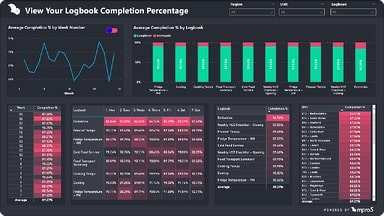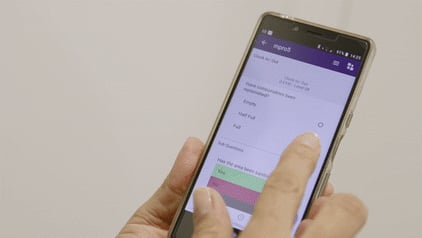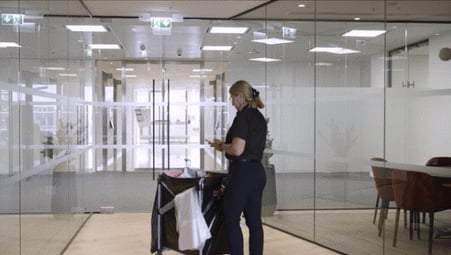What is Mobile Workforce Management (MWM)?
Mobile apps are everywhere and are coming more integral to every-day business and home life. Something that is becoming ever more apparent,...
5 min read
 Konnor Baskaran
Oct 11, 2022 12:00:00 PM
Konnor Baskaran
Oct 11, 2022 12:00:00 PM
High inflation, stagnating wages, economic recession and a world-wide pandemic have changed the workforce, in some ways that will probably take decades to fully understand. But there are some more immediate lessons that businesses can learn.
The Great Resignation was a clear signal that the workforce is frustrated not just by stagnating wages, but by dull manual jobs that never change, or offer any path to improving their skills and productivity.
A lack of innovation, limited investment in new tools and a general lack of creativity have created a sense in the workforce that the executive level of the business world is apathetic about their contributions.

One thing is clear: The 'Big Quit' shifted some power away from 'management' in favor of 'edge workers' - those who are a long way from headquarters, dealing with other employees and customers, and trying to meet their expectations.
The fact is, these 'edge workers' are critical to creating value and increasing customer satisfaction, they are a huge component of a company's offering, and this is particularly true in industries such as facilities management.
Leaders and managers in facilities management everywhere should keep productivity top of mind when trying to create a workplace that employees embrace. There are three key pillars of productivity to consider:
Can your employees relate to the value your business creates, and do they understand the importance of their role in that? If they see it as "just a job," then your productivity issues are more severe than you might think.
If this 'just a job' mentality is widespread, then you have to consider how well you are communicating your goals as a company: Your employees should understand how their efforts support your business strategy.
Action will mean more than words though - are your employees given the best tools for the job, or are they stuck doing rote and outdated processes that they know add little value? This is critical, but I'll explain this in more detail at the end.
-gif.gif?width=435&name=ezgif-com-gif-maker%20(2)-gif.gif)
The environment matters too. A cubicle farm tells employees they are dispensable and alone, and encourages nothing but the most minimal effort required to go unnoticed by a manager peering into their foxhole.
You might not need to go for a full interior redesign, but creating a varied office space that encourages collaboration, facilitates socialising, allows for quiet spaces and private areas, and has desks employees can call their own, will go a long way to making them feel a part of something.
It's crucial that your values and the output of the business are understood, and that your words are backed up by actions to make your workspace attractive and productive. This is how you connect your employees to the business.
Another facet of this to think about is the extent to which you employ the whole of someone, rather than just their time.
That might sound strange, but companies like Starbucks offer tuition reimbursements for their employees because, even if further education doesn't have a direct business benefit, it does show their team members that they care about personal development as whole.
Team empowerment further develops this relationship: flexible work hours, overtime, or the ability work from home, when possible and feasible.
Committing energy to the personal development of employees, whether it’s in or outside of work, is invaluable. The result is that as leaders work harder for their employees, they will be happier and work harder for their employers.
It's simple: give your teams the best tools they can have, and you will have higher rates of loyalty and productivity. Do the systems your employees use make their jobs easier, encourage collaboration or give them more time to do the things only people can do?
This matters a great deal because good tools demonstrate an understanding of ground operations at the top of your organisation, that you don't want your employees to be spending their time in drudgery.
Tools are a way of making otherwise tedious and time-consuming tasks easy, fast and reliable, so that teams can focus on adding intelligent, human value to their roles.
New, commercially viable technology can have a dramatic impact on productivity and help to improve employee stickiness. Automation is still the main aim, but the ways in which this can be deployed in your business have become very sophisticated in the last ten years, even outside of manufacturing.
Some tasks might always be manual (someone has to take the trash out), but it's not just the work itself that can benefit from new tech. How you assign jobs, measure success and communicate can be digitalized using workflow management and automation solutions.
-gif.gif?width=578&name=Spinny%20(5)-gif.gif)
These platforms can help you to streamline processes, particularly compliance and reporting, by eliminating the need for paperwork, whether that's store logbooks or audits.
This approach can be improved further with Internet of Things (IoT) solutions: smart sensors and cameras that can give you further information on assets and sites.
In any industry you work in, ask an employee what they dislike most about their job - because paperwork will be somewhere in their top ten.

Digitalising these processes can make them easy to carry out, and empowers employees by making this data useful to them in their own work, and dead-easy to report on.
Unleashing real-time data through dashboards can democratize your data, and
help employees at every level of your company to make better decisions, and to show the results of their ingenuity.
Digitalised workflow solutions, that use a mobile app to guide employees through processes, can tell them what tasks need to be done, where and at what time. Typically these platforms allow for ad-hoc jobs, and IoT sensor data can be used to drive dynamic scheduling.
To demonstrate how this works in practice, we can look at how this technology is used to implement dynamic cleaning schedules for bathrooms.
As anyone who works in facilities management knows, the cleanliness of bathrooms on any site is often the peak of the user experience, for better or worse.
The traditional way of keeping bathrooms clean is to post a paper schedule to the back of the restroom door, indicating the last time it was cleaned, the date and who did it. At the end of the day, the schedule might be taken down and placed in a logbook, ready to be dug out for audits and reporting.
"Poor communication, tedious paperwork and mistakes that happen as a result of these problems are demoralising and leave workers feeling powerless to improve."
But how do you know how well the job was done? Were all the consumables restocked; were the trash cans emptied?
And if there's a problem, like a blocked toilet or a cracked sink, how can you be sure this is even raised as a remedial action? It might be unclear who's responsible for reporting faults, chasing maintenance or tracking the progress of repairs. And when you're busy, it's easy to miss key steps.

This could leave urgent jobs forgotten until there's a complaint, an audit or an accident, which is simply too late.
Overtime, these problems can undermine not just your service but your employee morale, because poor communication, tedious paperwork and mistakes that happen as a result of these problems are demoralising and leave workers feeling powerless to improve.
Moving to works management and automation platform can radically improve productivity. Bathroom checks and cleans can be turned into thorough step-by-step processes for your employees to follow, with each step asking for the relevant data and additional information such as images.
This removes the ambiguity of what needs to be done and gives you data in structured format that's immediately useful.
Crucially, it empowers employees to easily report and issue, letting them take a picture and notify the maintenance team instantly. The remedial action can then be chased and tracked automatically, and closed down once the problem is fixed.
IoT sensors can also be added to these systems to make them even more useful, enabling dynamic ways of working.
Maintaining the cleanliness of bathrooms on a site is not easy, and it can be a frustrating case of going over already clean areas and missing ones that are in need of attention.
But smart door sensors can tell your works management platform how many times a bathroom has been used. When this number hits the set threshold, an alert will be sent to a cleaner to go and perform a bathroom clean and restock consumables including hand soap and toilet paper.

This is often known as 'Dynamic Scheduling', because the order of work is determined in real time by the level of demand for any given area. This is far more satisfying for cleaners, as their time is always well spent, and it is vastly more efficient than using a fixed schedule.
The productivity of companies in all industries, not least facilities management, can no longer be measured simply by comparing "output per minute" to "hourly wages".
Leaders who understand this and pay attention to the three pillars of employee productivity, and the potential of new technology, will reap the benefits of strong employee engagement and retention.
Like all major events, the Pandemic and the Great Resignation have forced businesses to consider these ideas: now is the time to create productive, positive environments that empower employees to go the extra mile.

Mobile apps are everywhere and are coming more integral to every-day business and home life. Something that is becoming ever more apparent,...

In recent years, the facilities management sector has experienced significant growth. In this piece, our team of experts explains why. Read on for...

How people work has changed significantly over recent years and technology has brought big changes to the workplace. The need to capture accurate...